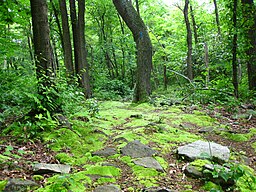Laurel Summit State Park
| Laurel Summit State Park | |
| Pennsylvania State Park | |
|
Wolf Rock Loop
|
|
| Country | United States |
|---|---|
| State | Pennsylvania |
| County | Westmoreland |
| Township | Cook |
| Location | |
| - elevation | 2,674 ft (815.0 m) |
| - coordinates | 40°07′04″N 79°10′30″W / 40.11778°N 79.17500°WCoordinates: 40°07′04″N 79°10′30″W / 40.11778°N 79.17500°W |
| Area | 6 acres (2 ha) |
| Founded | 1964 |
| Management | Pennsylvania Department of Conservation and Natural Resources |
| Website: Laurel Summit State Park | |
Laurel Summit State Park is a 6-acre (2.4 ha) Pennsylvania state park in Cook Township, Westmoreland County, Pennsylvania in the United States. It is also a picnic area with a scenic view of Linn Run on the summit of Laurel Mountain. The temperatures at Laurel Summit State Park are generally several degrees cooler than the surrounding towns in the valleys. The elevation of the park is 2,739 feet (835 m) above sea level.
The area in and surrounding Laurel Summit State Park is now a thriving second growth forest. One hundred years ago it was generally described as a "waste land". The ridges of the Laurel Mountain had once been covered with old-growth forest. These forests were clear cut during the lumber era that swept over most of the mountains and forests of Pennsylvania during the mid-to-late 19th century and very early 20th century. The lumberman stripped the mountains. They took the logs to the sawmill where they were cut into lumber. Smaller logs were used to reinforce the mine shafts of the many coal mines throughout southwestern Pennsylvania and West Virginia. The bark of the hemlock tree was used as a source of tannin at the tanneries of the area. The only thing the lumbermen left behind was the treetops. These tree tops were left to dry. The passing steam locomotives of the Pittsburgh, Westmoreland and Somerset Railroad would ignite this dry brush causing massive wildfires that swept through the mountains and valleys. In 1909, after the Commonwealth of Pennsylvania had purchased the land from the lumberman, Forester John R. Williams reported, "I should say that fully three-fifths (60%) of the reserve had been burned since the lumbering was done. The fires did great damage to the young growth. Some places were covered with nothing but ferns and blackberry bushes." Scars from these fires can still be seen today in the Laurel Summit vicinity.
...
Wikipedia


